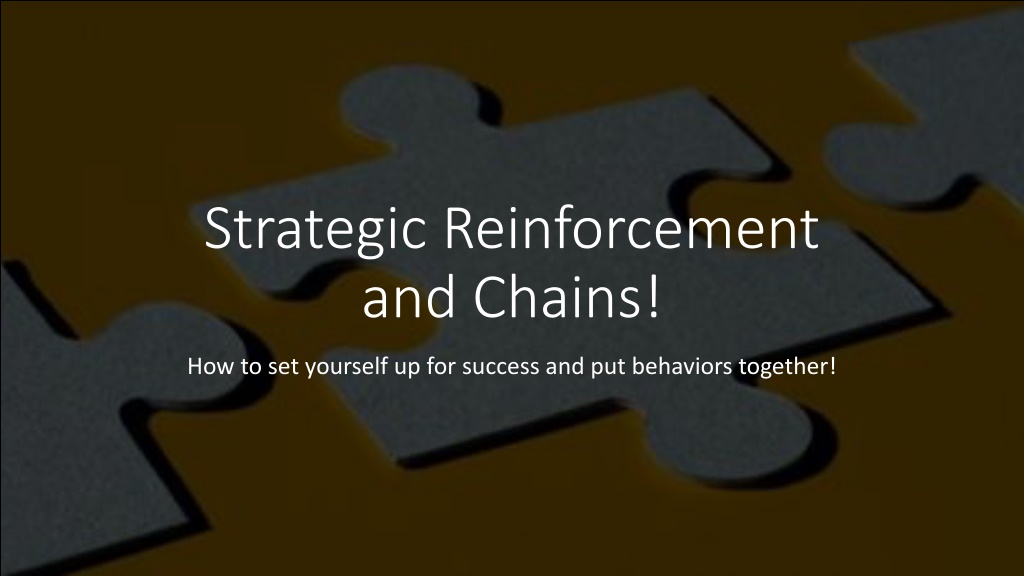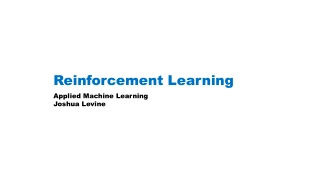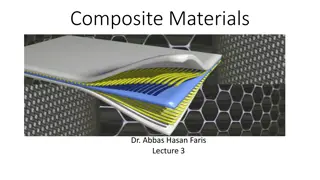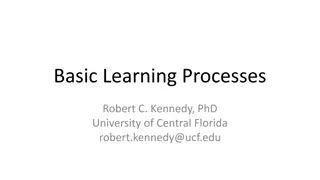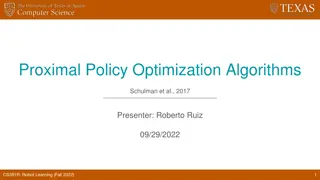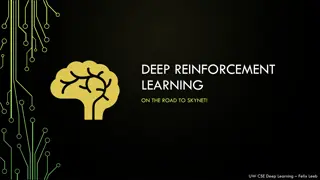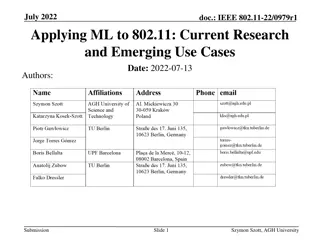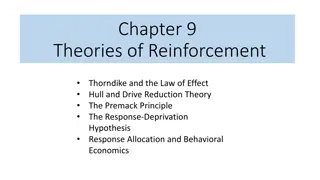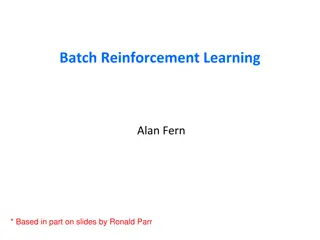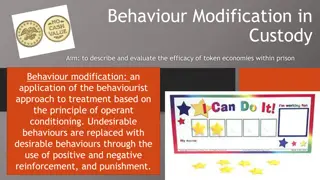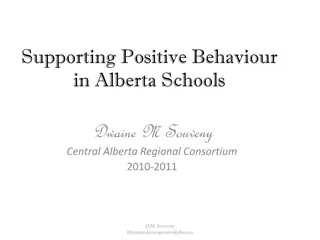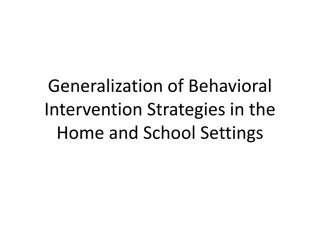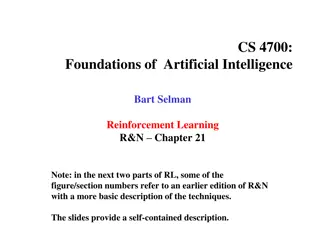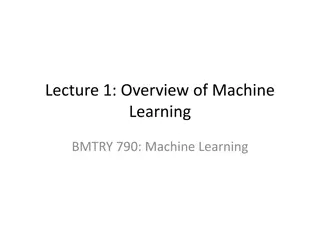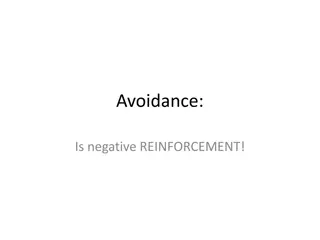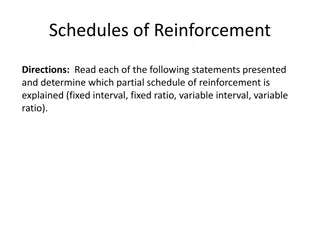Strategies for Effective Reinforcement in Training
Strategic reinforcement plays a crucial role in successful behavior training for animals. It involves planning each reward delivery to avoid additional behaviors and ensure smooth progress. Components like reward location and delivery method are essential for effective training. Safety considerations and the value of different reinforcers are important factors to consider. Introducing reinforcement strategies based on your animal, relationship, and training goals can enhance training outcomes.
Download Presentation

Please find below an Image/Link to download the presentation.
The content on the website is provided AS IS for your information and personal use only. It may not be sold, licensed, or shared on other websites without obtaining consent from the author.If you encounter any issues during the download, it is possible that the publisher has removed the file from their server.
You are allowed to download the files provided on this website for personal or commercial use, subject to the condition that they are used lawfully. All files are the property of their respective owners.
The content on the website is provided AS IS for your information and personal use only. It may not be sold, licensed, or shared on other websites without obtaining consent from the author.
E N D
Presentation Transcript
Strategic Reinforcement and Chains! How to set yourself up for success and put behaviors together!
EVERY reward is a delivery event This event greatly influences behavior Must be strategic in delivery of reinforcers Rewards = Rewards = powerful tool powerful tool That is: Each reward delivery should involve a plan!
Strategic Reinforcement does Strategic Reinforcement does NOT NOT ask for additional behavior ask for additional behavior After the click: delivery event must flow smoothly and NOT require more behavior before the dog receives his/her reward. Example: Click for sitting Dog gets up You require dog to sit back down to get the reward This is requiring an EXTRA behavior How to avoid this? Strategic Reinforcement!
TWO components make for very powerful training: Effective reward location Effective delivery method These two components Assist training progress Avoid hindering training progress Support preventing undesired behavior! Defining Defining Strategic Strategic Reinforcement Reinforcement Lack of strategic reinforcement: The trainer lowers success. Has no reward strategy The animal controls the delivery event = not so powerful training
Safety: Open hand vs. fingers accessible Must use a reward strategy that includes a safe and comfortable method of reward delivery for both trainer and the dog Many Reasons Many Reasons for Using for Using Strategic Strategic Reinforcement Reinforcement Convenience: Easy for the trainer to deliver Easy for the dog to get the reward But: doesn t ask for additional behavior OR disrupt the target response
Several considerations: Your animal Your relationship with the animal Value of different reinforcers available Mechanics of giving/taking reward How to How to Introduce Introduce Reinforcement Reinforcement Strategy Strategy into your into your training training You as a trainer Your ability The training goals Each behavior may have a different reward strategy
Reward Location Reward Location Location resets dog: places dog in best location for next repetition Rewards where the dog was at the time of the click (adding value to that location) Rewards at specific location (moves the dog) which supports the goal behavior Rewards where the dog is at time of delivery (may be different location from where click happened)
Reward Speed of Reward Speed of Delivery Delivery Speed of Delivery: Too fast: may startle the dog with the movement Too slow: not relate the reward to the behavior A Powerful reward event begins AFTER the click and is smooth from start to delivery This Photo by Unknown Author is licensed under CC BY-SA-NC
Relocating Animal via Preset Rewards Prompts the dog to move to the reward Remote controlled feeding machine Preplaced reward on a trained target (cue for taking reward) Reward Stationing: Other Delivery Other Delivery Strategies: Strategies: Use a frequently used reward location Place or position from which most behaviors are cued and/or most behaviors are reinforced E.g.: head position, in front of handler, on platform Protected contact: Physical set up limits animal s access to reward Reward delivery supports desired behavior: Waiting for delivery E.g., remaining behind a barrier to deliver the reward: animal waits for you to approach barrier and delivery safely
Pizza Delivery! Make it so there is NO NEED to TRAVEL to get the reward Direct Delivery: Prompts the dog to remain at the click location Come and Get It! Delivery Delivery Strategies Strategies Upon click: dog comes to reward at its location (usually handler) Reset dog for next repetition: Initial movement towards goal behavior is heavily reinforced Reset dog for Completion Point: final behavior position is more heavily reinforced Longer delivery Events: Distance Clicks Extend reward event time Reward is delivered to that distant location
Examples: Examples: Promoting a goal behavior: Down Dog lies down, click Where should you give reward to reinforce that position? Promoting goal behavior: Back up Dog backs up, click Where should you give reward to reinforce that position? Promoting heel position (dog on left side) Dog heels, click Dog moves to in front of you Where should you reinforce to keep dog in position?
Promoting a goal behavior: Ignore distractions Dog is walking along, not looking at distraction Click for this behavior Where should you give reward to reinforce that position? Promoting goal behavior: Dog comes off A-frame, must make contact with lower part of board Dog moves down ramp, hits yellow area Where should you give reward to reinforce that position? Examples: Examples: Promoting 4-feet on platform Dog gets x feet on platform, click Where should you reinforce to keep dog in position?
Chains When 1 behavior just isn t enough.
Remember: When we give a cue, we say it ONCE TIME! No repeating yourself (while the dog shapes you!) Give the cue Wait 3-5 seconds for the first behavior If no response: record as error and give cue again! Chains and Chains and Cues Cues REMEMBER When shaping: Work on 1 cue at a time until fluency Dog should be getting 8/10 cues correctly three sets of 10 in a row. But this is boring .so let s mix it up a little
Chains and Cues Chains and Cues A chain is a group of cues that lead to a primary reinforcer E.g.: Sit-Down-roll over-sit-up Each cue is a secondary reinforcer Many behaviors lead to a single primary reinforcer! Each cue in the chain: Serves as a (Secondary) REINFORCER for the previous response Serves as a CUE for the next behavior E.g.: Down reinforces sit and asks dog to down; roll over reinforces down and asks dog to roll over ..
Did I say that timing in chains is important? Timing in chains is important When you give your cue is critical! Timing in chains is important! Timing in Timing in Chains is Chains is IMPORTANT IMPORTANT Give the cue as animal BEGINS behavior E.g., as dog sits, cue Down If you wait until the end of the behavior, dog will have a pause as he waits for the next cue Must give the dog enough time to DO the next behavior Most problems with chains involve poor cue timing!
Start from first behavior and work towards the end E.g.: Shoe tying: Start with putting your foot in End with the final pull on the bow Forward chains: Two basic Two basic kinds of kinds of chains: chains: Start from the terminal (ending link) and work backwards to the start E.g.: Shoe tying: Start with the final pull on the bow Work backwards to the beginning Backward chains
Which is better? Forwards or Backwards? Generally backwards chains are better End closest to the reinforcer Instant success More easy to work backwards and build duration Two basic Two basic kinds of kinds of chains: chains: Forward chains are unavoidable: Consumable behaviors: e.g., potty training Problem: more distant to reinforcer So: reinforcer beginning steps and then add more steps before the reinforcer
The Animal Anticipates the Cue Blending of behaviors Poison cues Problems with Problems with Chains! Chains! Superstitious chains All can screw up your chain Must deal with issues carefully or you will destroy your chain.
Problems Chains! Problems Chains! Anticipating the Cues Anticipating the Cues Problem: The Animal Anticipates the Cue: After a few repetitions, an animal may anticipate the next cue and act before the cue is given. Common problem. Because the trainer sees the desired behavior, he or she doesn t realize that there is a cueing problem that will eventually jeopardize the chain. Without a cue reinforcing behavior #2, the behavior will begin to shorten and then to blend with behavior #3, and eventually will be lost from the chain.
Animal Anticipates the Cue: Animal Anticipates the Cue: The FIX The FIX Always practice portions or sub units (2 to 4 behaviors) within a chain much more often than the whole chain. Make sure EACH behavior in a chain is fluent by practicing them individually as needed. Don t over practice the chain in order or animal will anticipate and even blend.
Problem: Animal Anticipates the Cue: Problem: Animal Anticipates the Cue: The FIX .Break up the Chain! The FIX .Break up the Chain! When having a problem: Take three behaviors out of the chain: The one giving trouble, The one BEFORE it, a The one AFTER it. Give Cue #1, then cue #2 while #1 is going on, C/T. Then do the same with #2 And #3, Then with all three. If a behavior has completely broken down, Reshape the behavior Bring it under stimulus control with a new verbal cue or hand signal. Even in chains cues can become faulty and poisoned.
An Example: An Example: Navigating an A Frame Navigating an A Frame Teaching a dog to navigate agility equipment is often done by leading, luring, targeting, or shaping the dog through the process. For example: A-frame Might use a low version is used to start. The dog is shaped to go Near it, Touch it, Go part way up, Then a little farther, Until he goes all the way over. This Photo by Unknown Author is licensed under CC BY-SA
Common problem: Common problem: Jumping off too early Jumping off too early If the dog jumps off partway, the trainer starts again. In this process there is a lot of reinforcement for the going up part, but not much for the going down part which in actuality is the part we want to strengthen. The Solution: Start on the downward side Backward chain Work just on touching the contact zone and coming off, would be a way to teach the last part of the chain first. At this point the dog would be walking up the down side, turning and coming down. End behavior become MOST reinforced behavior This Photo by Unknown Author is licensed under CC BY-SA
Hazards of Praise and Clicks Hazards of Praise and Clicks During the Chain During the Chain Don t make your chain a poisoned cue! Many people don t realize that if you interrupt a well-established chain with a conditioned reinforcer that is not a cue (a click, or cheers and applause, for example), the animal will Expect and be looking for a primary reinforcer the treat, game, or other desired event usually received at the completion of the chain. But .An animal who is well skilled will do the chain in performance or competition without flaws, despite your cheers. Practice or build in interruptions and cheers if they will be environmental cues that may distract your dog. Why? Because even a few such interruptions may cause inexplicable breakdowns in future performances This Photo by Unknown Author is licensed under CC BY-SA
Superstitious Chains Superstitious Chains Superstitious chains = string of behaviors that the animal believes are linked and lead to reinforcement In actuality there is no contingency between the behaviors and the reinforcement In some cases these superstitious behaviors are true chains, Behaviors are linked by stimuli the animal perceives as cues. Sometimes strings of behaviors that develop are simply a pattern or series of behaviors that the animal has strung together. To the animal, they are essentially one behavior. Becomes a fluent behavior rather than a bunch of individual behaviors Harder to change the order of the cues because of fluency of the blended behavior. This Photo by Unknown Author is licensed under CC BY-NC-ND
Superstitious Chains Superstitious Chains Example: Dog runs to the door at the sound of the doorbell, then spins and jumps The dog may pair running/spinning/jumping with what makes the door open (the reinforcement), In fact the door opening is not contingent on the dog s behavior at all. Another example: A dog hears doorbell, sees a toy and grabs it, and runs to the door Developed a chain that s held together by environmental cues: Door opening is the cue for grab the toy Toy is the cue for run to the door. The chain is then reinforced by attention and a tossed toy from the person entering. Solution: If the toy Is not available or In sight when the dog hears the door opening, this superstitious chain will quickly break down ..and dog misbehaves . This Photo by Unknown Author is licensed under CC BY-SA In this case, the dog stops running to the door because you have interrupted his or her chain. NOW you use the superstitious chain against him, so to speak .break up the superstitious chain and it stops the behaivor. Question: Do you want this behavior or not? If you do .reinforce it explicitly!
But What Does the Research Say About Training Procedures? Three studies: Meyer and Ladewig (2008) show how much training is necessary Chiandetti, Avella, Fongaro & Cerri 2016: Examines clicker vs. Voice vs. Just food Thorn, Templeton, Van Winkle & Castill0, 2006: Examined quick and dirty training program for shelters
Examined how often training should be conducted to get best training results Very few studies examined this Many reasons why: Dogs are owned, and people differ greatly in their handling/training Laboratory dogs aren t really a good comparison Meyer and Ladewig (2008) Massed vs. spaced training: Most research shows that spaced training results in better learning and retention Is this true for dogs?
18 dogs: Laboratory beagles Divided into 2 groups Dogs trained 1x per week or Dogs trained 5 days per week All trained by same person in familiar environment with food reward Procedure The shaping exercise: Perform paw on target behavior while on a table stand Place paw on mouse pad (touch) 1 meter away from trainer Criteria of 80% correct responses for each of three steps
All dogs completed the shaping task through Step 3 Results showed FEWER training sessions was more effective Results 1x/week: averaged 6.7 training sessions to criterion. 2x/week: averaged 9 training sessions Dogs trained 1x week had higher average success rate
Is consistent with research with other animals Rat Horse Pigeon Even people Discussion: Why less training = better? More time allows for building of long term retention? Maybe Less habituation to the task? Dogs trained 1x per week may have been less bored This was a very simple task; Attention may have been better Does suggest that 1 to 2 training sessions per week is sufficient and daily may be too much if working on SAME task!
Research shows dogs form very strong attachments to owners/trainers/family Is this because we provide food and reinforcers? Is it a social attachment (perhaps even .love?) Is it a combination of both? Feuerbacher & Wynne (2014) Social interactions as reinforcers for dogs: Petting was a better reinforcer than verbal praise Petting and social encouragement could be as powerful as food reinforcement
Examined canine choice during CONCURRENT choice Both food and social praise/petting were available at the same time Varied reinforcement schedules for each alternative Feuerbacher & Wynne (2014) Wanted to determine which was more powerful reinforcer
Subjects: All at least 6 mos old 20 owned dogs at local daycare 27 owned dogs in laboratory 13 shelter dogs from local shelter Owned dogs in home for at least 4 mos Many different breeds Setting and procedure: Feuerbacher & Wynne (2014) Experimenter sat behind barrier, ran the camera and took data 2 chairs side by side (About 6 ft apart); Area marked area around chair with tape, designated this area as inside for proximity Undergrads sat in chairs; delivered food or pets according to reinforcement schedule 5 sessions: Food was available on 5 reinforcement schedules: Continuously, FI-15, FT-60, EXT, and then continuously
Concurrent interaction choices Petting was delivered as long as dog remained in proximity area (held constant as continuous reinforcement) Again: Other assistant provided food when dog was in proximity Continuous food: FI 15-sec; FI 60-s or EXT when dog was in proximity Continuous food was about every 4-5 seconds apart No discriminative stimulus as to when food delivered Feuerbacher & Wynne (2014) Conditions: 5 min sessions; consecutively each day Several Conditions: Owner-unfamiliar person: No food deprivation Owner-familiar person Shelter dogs
Stranger-familiar showed greatest time allocation to food, and least time for petting Even when food was on EXT Almost never chose petting 80% maintained food preference Feuerbacher & Wynne (2014) Owner-unfamiliar-deprivation and owner-unfamiliar- no deprivation dogs showed greatest allocation to petting! Most preferred food to petting in session 1 More than of dogs that preferred food in session 1 showed preference reversal as food schedule was thinned Had initial food preference of over 70% RESULTS: Time allocation Shelter dogs: preferred petting, even when food readily available Intermediate initial preferences for food In general, dogs lessened preference for food as food schedule was thinned and when around a stranger or unfamiliar setting
Solid line is food Dashed line is petting Boxes are numbers of treats Each dot is a session: X Axis is duration spent getting pets or food Y AXIS: Session 1: Continuous food Session 2: Food contingent every 15 sec. Session 3: Food noncontingent every 1 min Session 4: Extinction Session 5: Continuous food
Most OWNED dogs preferred food over petting when with their owner in familiar location. As food reinforcement was thinned, preferences began to switch to petting Shelter dogs had strongest preference for petting Feuerbacher & Wynne (2014) Conclusions Dogs in familiar environment with stranger maintained strong food preference, even when food was put on EXT Level of food deprivation did not change this Owner absent or being in unfamiliar setting increased preference for petting (especially as food reinforcement was thinned
Why? How much petting do owned dogs versus shelter dogs receive? How many treats? Feuerbacher & Wynne (2014) How could familiarity of setting or owner absence affect the responsiveness to food/petting? What does this tell us about OUR dogs?
We are preparing our dogs for adoption or helping them stay in their homes. You are a critical training manager for these dogs Without it they might not get adopted or stay in their homes! USE CLEAN chains of behavior. Break up your chain if it breaks down Practice its components Carefully rebuild Watch out for unwanted superstitious chains Reshape and retrain right away if a behavior is disintegrating/blending Take Home Message: Take Home Message: BE consistent USE positive Reinforcement: BOTH food and PETTING/TOUCH But be aware of each dog s needs Shy dogs may refuse both Less secure dogs may want more physical touch Securely attached dogs may prefer food
